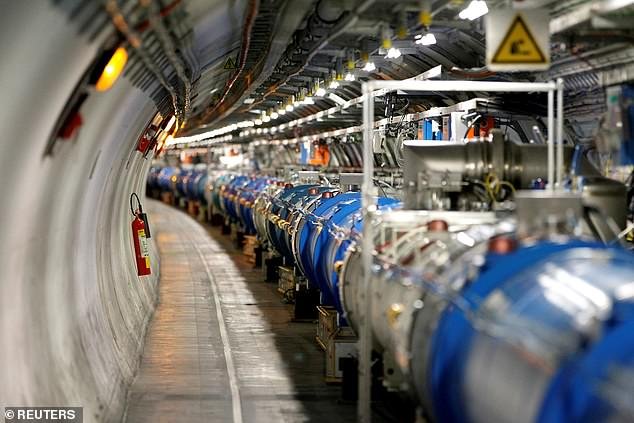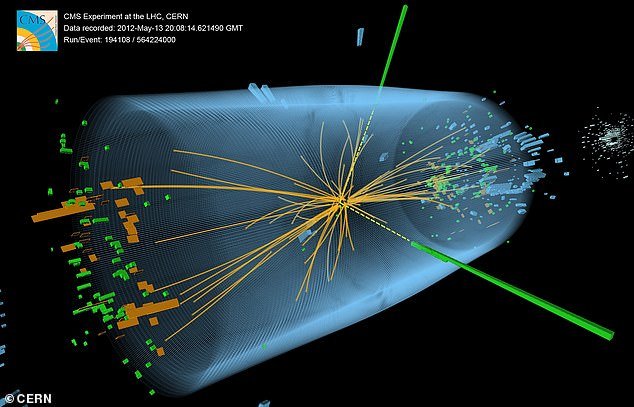CERN will test the world’s most powerful particle accelerator during April’s solar eclipse to search for ‘invisible’ matter secretly powering our universe
The world’s largest and most powerful particle accelerator will smash protons together on April 8 to search for invisible particles that secretly power our universe.
Theories have suggested that there are 17 different groups of particles The European Organization for Nuclear Research, better known as CERN, confirmed its existence in 2012 using the Large Hadron Collider (LHC).
Now the team has restarted LHC after a two-year hibernation in the hope of unraveling more mysterious matter, especially dark matter.
Scientists began preliminary tests by sending billions of protons around the LHC ring of superconducting magnets to boost their energy and ensure the $4 billion machine was in working order.
And further Next month, CERN will shoot them through a 27-kilometer-long tunnel at nearly the speed of light to recreate conditions a second after the Big Bang.
The European Organization for Nuclear Research, better known as CERN, announced this month that it has restarted the underground Large Hadron Collider (LHC), sending beams of protons around the massive circular machine.
LHC will continue the experiment until later this year, after which it will be put into a long hibernation so that CERN can transform it into the next version: the High Luminosity LHC (HL-LHC).
LHC is located 90 meters underground on the border of France and Switzerland and went live for the first time on September 10, 2008.
The LHC works by smashing protons together to break them apart and discover the subatomic particles that exist within them and how they interact.
CERN researchers use protons because they are heavier particles.
The weight ensures a much lower energy loss per turn through the accelerator than other particles such as photons.
Scientists turned on the powerful machine this month and injected it with several beams of protons.

The team is now preparing to send the beams through the 27 kilometer long tunnel at the speed of light, in the hope of unraveling the mystery of our universe.
On March 8, teams from around the world waited in the underground laboratory for a glimpse of the beams circling the LHC ring.
The round shape is designed in such a way that there is more time for the particle beam to accelerate, so that higher energy can be achieved.
But the first attempt this month did not go as planned after the beam only came partially around.
But this month’s experiments showed that the beam’s trajectory was wrong, because it made a complete circle.
But after tinkering with the mechanics, the team watched in amazement as the beam circled the accelerator in less than 20 minutes.
At full power, trillions of protons will race around the LHC accelerator ring 11,245 times per second, traveling just 7 miles per hour less than the speed of light.
On April 8, the team sends the beams through the tunnel where they collide.
The team will hunt for dark matter, which makes up about 28 percent of our vast universe, but has never been seen or proven.
This work will give them insight into the formation of the universe and even its ultimate fate.
The experiment is expected to take place on the same day as the Great North American Solar Eclipse.

CERN uses protons because they are heavier particles that have a much lower energy per turn through the accelerator. The purpose of LHC is to test predictions of various particle physics, including measuring the properties of the Higgs boson or the God boson (photo)
Total solar energy occurs when the moon completely blocks the face of the sun, causing the outside sky to briefly darken during the day.
The spectacle will be visible to an estimated 32 million people along a narrow path through North and Central America.
It will be the first total solar eclipse observed in the US since August 2017.
The purpose of LHC is to let scientists test predictions of different particle physicsincluding measuring the properties of the Higgs boson or the God particle, which has been a missing piece in the puzzle for physicists in their attempts to understand how the universe works.
Scientists believe that a fraction of a second after the Big Bang, which created the universe, an invisible energy field called the Higgs field was created.
As particles moved through the field, they picked up mass, giving them size and shape and allowing them to form the atoms that make up you, everything around you, and everything in the universe.
This was the theory proposed in 1964 by former grammar school boy Professor Higgs, and which has now been confirmed.
And while the particles decayed almost instantly during the LHC experiment, scientists found that they left behind a footprint that revealed their existence.
LHC is typically used for only one month per year, but has been shut down for long periods for upgrades; the LHC was last shut down in 2022, during the European energy crisis.
Lighting the almost LHC is a complex process, where everything has to ‘work like an orchestra’.
Rende Steerenberg, responsible for control room operations at CERN in Switzerland, said in 2022: “This is accompanied by a certain feeling of tension and nervousness,” he explained, adding that a lot can go wrong, including obstacles in the tunnel and problems with magnets.’
